Pump Handbook by Igor J. Karassik, Joseph P. Messina, Paul Cooper, Charles C. Heald - 3rd edition
Подождите немного. Документ загружается.

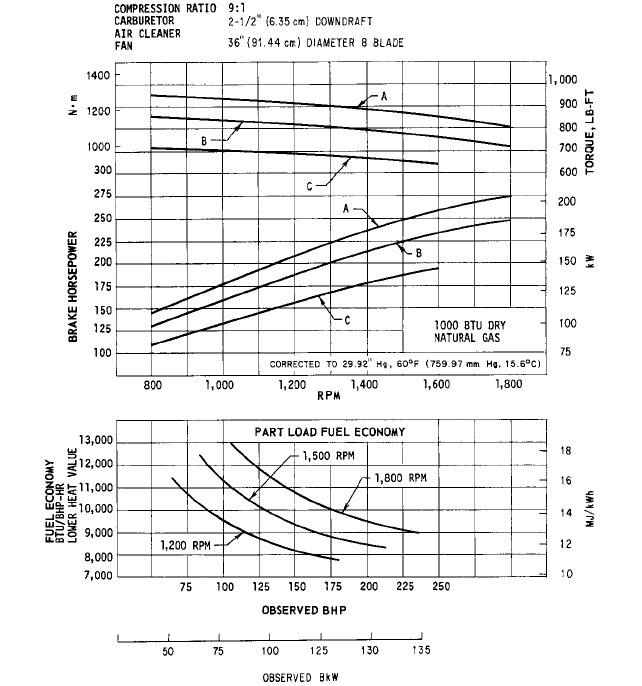
6.64 CHAPTER SIX
FIGURE 5B Gas engine performance curves: (A) maximum, (B) intermittent, (C) continuous ratings of engines
with accessories (Waukesha Motor)
• Variation in the heat-exchanger coolant temperature
• Entrapment of substantial quantities of air in the coolant water
• Inability to maintain a clean cooling system
With any cooling system, one of the most important factors of design is the tempera-
ture drop across the engine. Most engine manufacturers desire a temperature differential
of no more than 10 to 12°F (5.6 to 6.7°C), and closer values are desirable. A jacket-water
temperature across the engine of 170°F (77°C) is preferred, and in high-temperature or
waste-heat-recovery systems, temperatures of 200°F (93°C) or more are common and not
harmful.
Radiator The radiator cooling system is perhaps the most common and best understood
method of cooling. It is based on a closed system of tubes through which the jacket water
passes. The heat is dissipated by a fan, creating a stream of moving air passing through
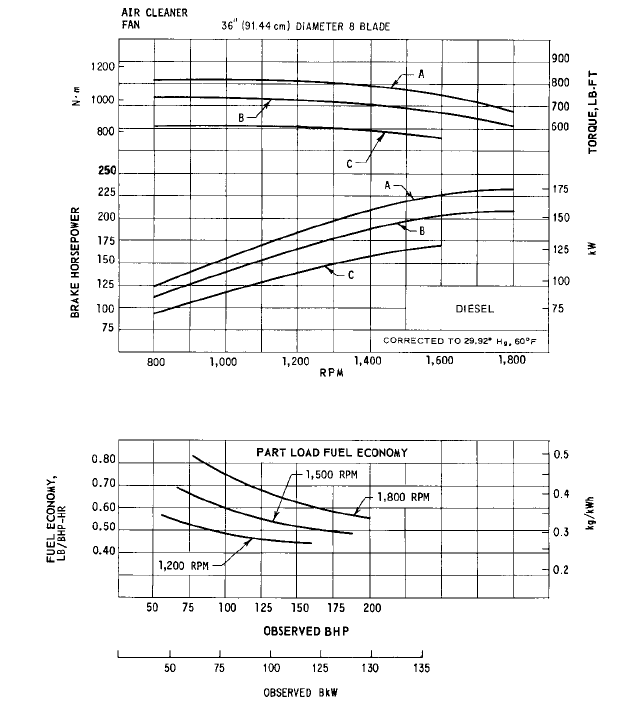
6.1.3 ENGINES 6.65
FIGURE 5C Diesel engine performance curves: (A) maximum, (B) intermittent, (C) continuous ratings of engines
with accessories (Waukesha Motor)
the tubes. The fan is driven either by the engine or by an auxiliary source of power (Fig-
ure 7).
An engine in a fixed outside installation can be cooled without much difficulty. Certain
factors must be considered, such as ambient temperature, direction of the prevailing wind,
and presence of foreign airborne materials. In high temperatures (usually above 110°F
[48°C]), a larger radiator is required. If the prevailing winds are extremely high, the unit
can be located to offset normal fan flow. Screening can be used to prevent the clogging of
the air passes in the radiator where the atmosphere tends to contain foreign airborne
material, such as dust.
Radiator cooling may be used in an inside installation, but there are certain problems
which, unless properly anticipated, limit this system. The recirculation of cooling air and
the radiation of exhaust heat from the engine create a problem. As was previously pointed
out, every 10°F (5.6°C) rise above 60°F (15.6°C) results in a 1% loss in power. When 5 to
10% of the total heat put into an engine is radiated, some means of power ventilation must
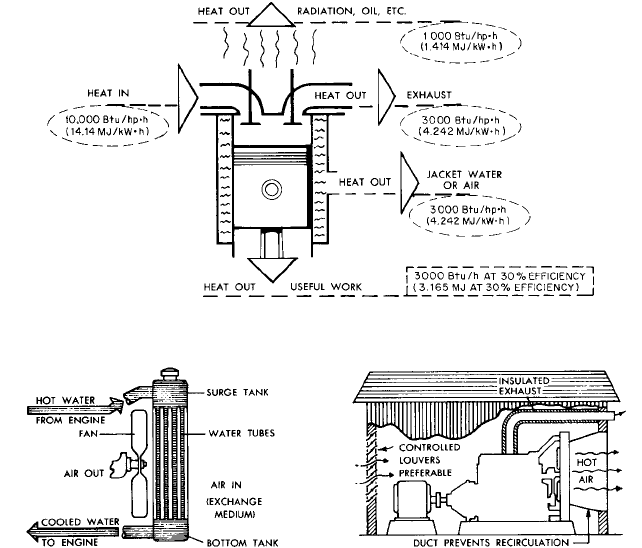
6.66 CHAPTER SIX
FIGURE 6 Hypothetical heat balance (Waukesha Motor)
FIGURE 7 Radiator cooling system (Waukesha
Motor)
FIGURE 8 Radiator cooling system for an inside
installation (Waukesha Motor)
be provided to remove this heat through ducts, louvers, or forced ventilation with a sepa-
rate fan. An installation of this type is illustrated in Figure 8.
Heat Exchanger The heat exchanger cooling system (Figure 9) is the best system for a
stationary engine installation. Using a tube bundle in a closed shell, the cooling exchange
medium is water (often called raw water). This water may be plant or process water; it may
be recirculated or, in standby installations, allowed to pass to waste. The system has the
advantage of the radiator cooling system in that it is self-contained: the quantity and qual-
ity of the water in the engine can be controlled. It has the further advantage of not being
affected by the flow of heat to air movement if the heat of radiation is taken into account
in the design of the system. On the other hand, the cooling medium, unless used in a plant
system, is a disadvantage because it is costly. A separate pump is required to provide the
necessary water for cooling unless city water or process water is under sufficient pressure.
City Water and Standpipe City water cooling is designed to take water directly from
the city main or from the pump the engine is driving. It is used on some emergency or
standby installation. It is simple and inexpensive, gives unlimited cooling for moderate-
size engines, is easily understood, and will operate instantly in an emergency. On the neg-
ative side, the cooling water is wasted, corrosive elements may be introduced into the
engine jacket water system, and it may create excessive temperature changes across the
engine jacket.
Standpipe cooling (Figure 10) is basically the same as city water cooling except that a
thermostatic valve is employed to admit makeup water as required. The vertical pipe is a
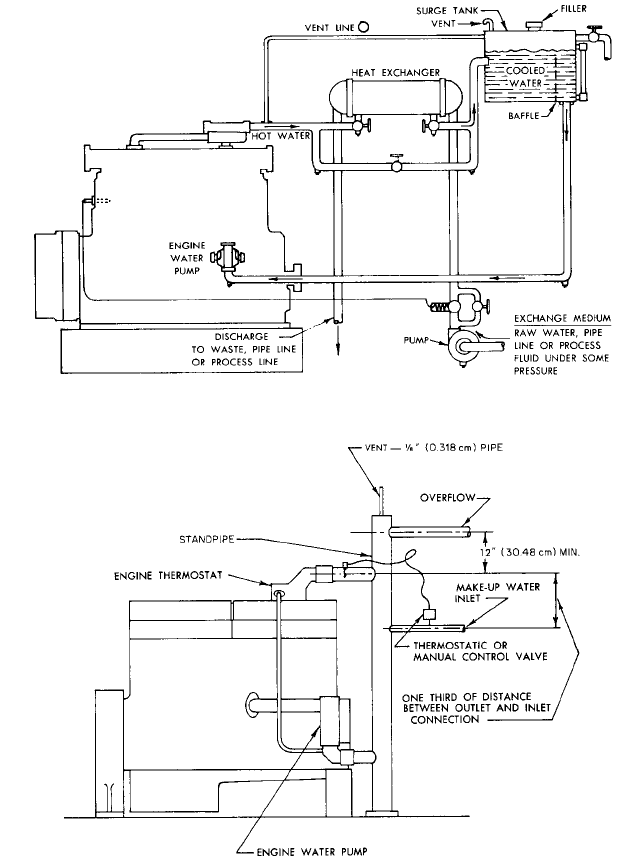
6.1.3 ENGINES 6.67
FIGURE 9 Heat exchanger cooling system (Waukesha Motor)
FIGURE 10 Standpipe cooling system (Waukesha Motor)
blending tank into which city water is introduced only in the amount necessary for
makeup. The standpipe system is inexpensive and simple to operate.
Ebullition In installations where heat is required for process equipment, a method of
high-temperature, or ebullition, cooling is being used as a very economical method, par-
ticularly with larger installations. This system has been termed steam cooling, high-
temperature, or Vapor-phase (a registered trademark). In this system, the coolant leaves
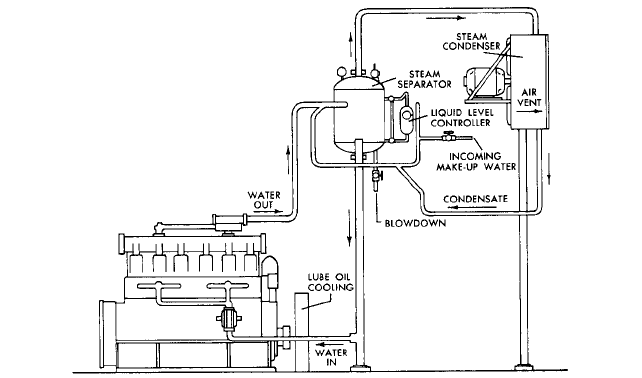
6.68 CHAPTER SIX
FIGURE 11 High-temperature cooling system (Waukesha Motor)
the engine at a temperature equal to or above its atmospheric boiling point and under
sufficient pressure to remain liquid until discharged from the engine into a flash cham-
ber, where a drop in pressure causes the formation of steam, which is condensed and
returned to the engine at very near the discharge temperature. A schematic of this sys-
tem is shown in Figure 11. This system has the advantages of a very small temperature
differential across the engine, which minimizes distortion of all working parts, and a con-
stant working temperature regardless of load. Because of the higher working tempera-
tures, the combustion area and crankcase of the engine have fewer liquid by-products of
combustion and corrosive materials. Of prime importance is the waste heat that can be
recovered for plant process with a very small amount of makeup water for cooling.
Cooling Tower Cooling towers are used in some large or multiple-engine installations.
Through the use of a current of air, produced either by a natural draft or by mechanical
means, a tower causes a sensible heat flow from the cooling water to the air. Atmospheric,
or natural, draft towers depend upon natural wind velocities and thus can vary widely.
Mechanical draft towers, where the air supply can be controlled, can be put in any area,
but the limit to their cooling capacity is the power required to operate them. As the water
volume increases, the volume of air required and the pressure the fan has to operate
against increase. A point is reached where the cost of installation and operation becomes
prohibitive.A diagram of a system that combines components of the cooling systems men-
tioned plus the waste-heat recovery system silencer, to be mentioned later, is shown in
Figure 12.
AIR-INTAKE SYSTEMS ________________________________________________
A most important consideration in the application of an engine to any pump drive is the
engine’s ability to “breathe.” As air is required for combustion, the design engineers of any
project must take into account the necessary provisions for this air. The environment, the
service, the speed range of the engine, the duty cycle, and the location from which the com-
bustion air is to be taken are of vital importance.
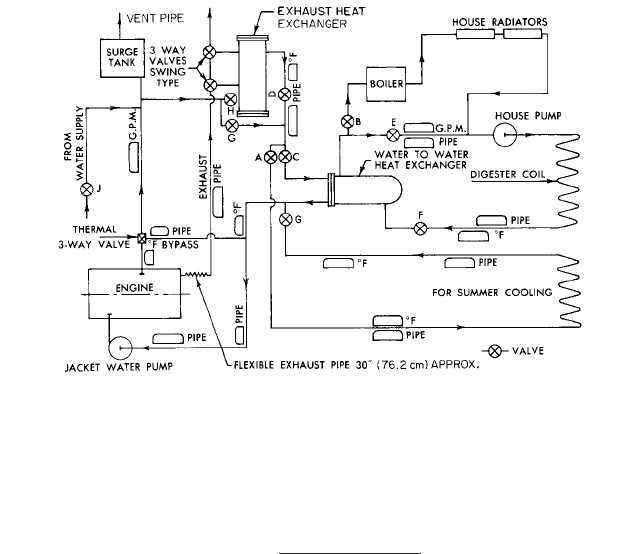
6.1.3 ENGINES 6.69
FIGURE 12 Complete cooling system, including waste-heat recovery (Waukesha Motor)
The first step in the selection of any intake system is to determine the volume of air, in
cubic feet per minute (cubic meters per second) required for combustion, which may be cal-
culated by the formula:
where B cylinder bore, in (cm)
S piston stroke, in (cm)
rpm engine speed, revs/minute
N number of cylinders
C 2,200 for V
ideal
in CFM or 76.39 10
6
for V
ideal
in m
3
/s
K 1 for two-stroke cycle and 2 for four-stroke cycle
Volumetric efficiency, defined as the ratio of actual air flow to ideal air flow, will vary
with engine design, but an average of 80% may be used to determine the air cleaner size.
Two-stroke cycle engines will require approximately 140% air flow calculated by the above
equation. For supercharged and turbocharged engines, the air flow requirements should
be obtained from the manufacturer.
The two basic cleaners available are wet and dry. The wet, or oil-bath, cleaner consists
of either an oil wire mesh or an oil bath through which the air must pass. A dry cleaner
uses a paper or cloth filter that traps dust, lint, and so on but allows the air to pass
through.
The installation of a suitable air cleaner is important. In cases where adequate air can
be supplied through proper ventilation of the area surrounding the engine, it is best to
mount the cleaner on the engine. If it is necessary to bring air to the engine from outside
the area of the building, certain design factors must be considered. The pipe connections
from an outside cleaner should be tight and mechanically strong, and fabric hose should
not be used unless the length is relatively short. The air to the engine should not be heated
by close proximity to the engine or any other heating device because, as previously men-
tioned, power loss occurs with air temperatures above 60°F (15.6°C). To avoid restrictions
V
ideal
B
2
S rpm N
C K
6.70 CHAPTER SIX
in the system, there should be no sharp bends in the piping. Finally, any outside air
cleaner must be designed so moisture such as rain or snow cannot enter the system.
The air cleaner system on a turbocharged engine must be able to remove any impuri-
ties in the air that would be detrimental to the efficiency of the turbocharger. Because of
the increased air requirements, a larger air-cleaner system must be used on such units.
EXHAUST SYSTEMS __________________________________________________
An engine consumes a large volume of air for combustion, and that volume must be
removed after combustion. It is necessary that the exhaust back pressure be kept at a min-
imum while this volume is being removed. The exhaust piping should be properly sized,
and long sweep elbows should be employed if necessary. Unless the back pressure is kept
low, the following conditions can result:
• Loss of power
• Poor fuel economy
• High combustion temperatures with increased maintenance
• High jacket water temperatures
• Crankcase sludging with resulting corrosion and bearing wear
All internal combustion engines create noise. Depending upon the location of the
engine, this noise can be a problem. Normally, when measured from a distance of about 10
ft (3 m), an unmuffled engine creates a decibel noise level ranging from 100 for the small-
and medium-size engine to 125 for the larger engine.Thus most engine installations incor-
porate some form of exhaust silencer, or muffler. Depending upon the degree of silencing,
a muffler will reduce the unmuffled decibel reading by 30 to 35 dB. Various types are man-
ufactured to meet the required conditions and are classified as follows:
• Standard or industrial
• Semiresidential (high-degree)
• Residential or hospital (supercritical)
The basic exhaust silencer is designed as either a dry type or wet type. The latter is
used in installations such as sewage or water treatment plants, where the recovery of heat
for plant processes is important. Basically this type may be classified as a low-pressure
boiler. Water is admitted to the silencer through tubes or coils to pick up the heat from the
exhaust. As shown in Figure 6, approximately 30% of the total heat input into the engine
is exhausted. The wet-type silencer is designed to regain about 60 to 70% of this beat. This
silencer has an advantage in its ability to operate either wet or dry. Thus when heat is not
required, it may be operated dry and vice versa.
STARTING SYSTEMS _________________________________________________
Starting methods for engines fall into two broad categories: direct and auxiliary.
Direct The direct system, used primarily with large engines, employs some means of
exerting a rotating force on the crankshaft, such as the introduction of high-pressure air
directly into the cylinders of the engine. A direct system on small air- or water-cooled
engines using either a rope or a hand crank has to a large extent been discarded in favor
of an auxiliary method.
Auxiliary The auxiliary system employs a small gear that meshes with a larger gear
(ring gear) on the engine flywheel. The ratio of the number of gear teeth on the large gear
6.1.3 ENGINES 6.71
to those on the small gear is called the cranking ratio. Generally, the larger the ratio, the
better the cranking performance. The auxiliary system uses several means to drive the
small gear:
• Electric motor
• Air motor
• Hydraulic motor
• Auxiliary engine
ELECTRIC MOTOR
The electric motor may be either dc or ac. The dc motor most commonly
used is available in 6, 12, 24, or 32 V. The voltage size will depend upon the size of the
engine, the ambient temperature, and the desired cranking speed of the engine. The dc
system requires a source of outside power, usually in the form of a storage battery. To
assure prompt starting, a charging system for the battery is required in the form of either
a charging generator driven by the engine or an ac-powered battery trickle charger. The
latter is recommended for standby installations where an engine-driven charging gener-
ator functions only when the engine is operating. During idle periods, the battery will lose
its charge unless maintained by a trickle charger. In recent years, there has been a trend
toward the use of an ac generator, or alternator, which has the advantages of small size,
higher voltage and amperage, competitive price, and good charging ability under idle
speed conditions.
Another type of electric motor is a line voltage starter available in 110, 220, or 440V ac.
It has the advantages of faster and more powerful cranking, the elimination of the battery
and charging system, less maintenance, and sustained cranking through unlimited avail-
able electric power. Its disadvantages are a higher initial cost, the requirement of high line
voltage at the site, the danger to personnel due to the high voltage, and the requirement
to conform to existing wiring and installation codes.
AIR MOTOR
The air motor, which is usually of the rotary-vane type, uses high-pressure air
in the range of 50 to 150 lb/in
2
(340 to 1030 kPa) to turn it in starting the engine. It is
mounted on the engine flywheel housing to mesh with the gear on the flywheel in the
same manner as the electric motor. An outside source of air from an air compressor, usu-
ally with a 250-lb/in
2
(1720-kPa) capacity, is required. A pressure-reducing valve is
installed in the line to the engine. The high-pressure air stored in an adequate receiver
is sufficient for several starting cycles. This starting system has the advantages of faster
cranking, sustained cranking as long as the air supply lasts, suitability in hazardous loca-
tions where an electric system might be dangerous, and ability to operate on either com-
pressed air or high-pressure natural gas. Its disadvantages include a higher initial cost,
the requirement of an air-compressor system, and, finally, a shutdown condition if the air
supply is depleted before the engine starts.
HYDRAULIC MOTOR The hydraulic motor system consists of the motor, an oil reservoir, an
accumulator, and some means of charging the accumulator. The accumulator, which is a
simple cylinder with a piston, is charged on one side with nitrogen gas. As the hydraulic
fluid, usually oil, is pumped into the other side, the gas is compressed to a very high pres-
sure. When released, the fluid turns the motor, which in turn rotates the engine. The sys-
tem can be charged by hand, with an engine-driven pump, or with an electric motor-driven
pump. Generally, an engine-driven or electric-motor-driven pump is used in conjunction
with the hand pump in case of an engine or electrical failure. This system has the same
basic advantages of the air motor except that there is no prolonged starting. If the engine
is in good operating condition, the cranking is fast and a start is instantaneous, but, if not,
it is necessary to recharge the system before another start can be made.
AUXILIARY ENGINE A small auxiliary air-cooled or water-cooled engine is sometimes
employed for starting. It may be mounted on the engine in the same manner as the other
systems, or a belt drive may be employed. Some form of speed reduction is required to
reduce the higher speed of the auxiliary engine to that required for proper cranking. The
6.72 CHAPTER SIX
principal advantage of such a system is a complete independence from outside sources of
power, such as batteries, air, or pumps, but this is offset by a higher initial cost and the
required regular maintenance of the engine.
IGNITION SYSTEMS __________________________________________________
The internal combustion engine requires some means of igniting the combustible charge
in the cylinder at the proper time. Today’s high-compression gasoline and gas engines
demand a system that will produce a high-tension spark across a short gap in the com-
bustion chamber for the ignition of the charge. It is obvious that the design of the com-
bustion chamber must be such that this combustible mixture of fuel and air is present
between the discharge gap when the spark occurs; otherwise, ignition will not take place.
Ignition systems for gasoline or gas engines are considered high or low tension. The
energy system for the high-tension system is either an electric generator and battery or a
magneto. The generator and battery produce a direct current at 6 to 12 V potential, and
the magneto produces an alternating current with higher peak voltages. With either
energy source, this system has a primary circuit for the low-voltage current and a sec-
ondary circuit for the high-voltage current.
The primary circuit consists of the battery, an ammeter, an ignition switch, a primary
coil, and breaker points and a condenser in the distributor. When the ignition switch and
the breaker points close, a current flows through the circuit and builds up a magnetic field
in the primary coil. Opening the breaker points breaks this circuit, causing the magnetic
field to start collapsing.As the field collapses, it produces a current that flows in the same
direction in the primary circuit and charges the condenser plates. The condenser builds up
a potential opposing flow, which discharges back through the current. This results in a
sudden collapse of the remaining magnetic field and the induction of a high voltage into
the secondary winding of the coil. The breaker points are opened and closed by a cam
which is engine-driven, usually at half engine speed.
The secondary circuit consists of the secondary coil winding, the lead to the distributor
rotor, the distributor, the spark plug leads or wires, and the spark plug. A magneto elimi-
nates the battery, but includes in its construction the balance of both primary and sec-
ondary circuits. It may have either a rotating coil and stationary permanent magnets or a
stationary coil and rotating magnets. The relative movement of the primary coil winding
and the magnets induces an alternating current in the primary circuit, the breaking of
which induces a high-voltage current in the secondary circuit.
The development of the modern engine has required many refinements in spark plug
design, but basically a spark plug consists of two electrodes, one grounded through the
shell of the plug and the other insulated with porcelain or mica. The insulated electrode is
exposed to the combustion. The heat flow occurs from this electrode to the spark plug shell
through the grounded electrode.
Recent developments in ignition systems have produced the low-tension and breaker-
less systems. The breakerless system has eliminated most of the moving parts in the dis-
tributor system. The breaker points in the distributor system are actually a switch that
opens and closes the primary circuit of an ignition coil. In the breakerless system, the use
of solid-state devices provides a switch with no moving parts to wear or require adjustment.
The low-tension magneto system has been developed to reduce electrical stresses in the
ignition circuit. The secondary coil has been removed from the magneto proper and relo-
cated near each spark plug. The low voltage generated by the magneto is transmitted
through the wiring harness to secondary coils, which then step up to the voltage to be
transmitted through short leads to the spark plug. These leads may be insulated to with-
stand the stresses imposed upon them. This results in a minimum of electrical stresses
with a resulting longer life of all components of the system.
As was mentioned previously under fuel systems, the diesel engine used the heat of
compression for ignition; thus no auxiliary systems, such as the systems mentioned above,
are required. The fuel is injected into the combustion chamber under relatively high pres-
sure through the use of a fuel pump and injection nozzle. This system may be either an

6.1.3 ENGINES 6.73
individual pump and nozzle for each cylinder, commonly called a unit injection, or a mul-
ticylinder pump that maintains a high pressure in a common fuel line connected to each
injection nozzle. The latter is normally called the common rail system.
ENGINE INSTALLATIONS ______________________________________________
Foundation
The correct foundation, mounting, vibration isolation, and alignment are
most important to the success of any engine installation. All stationary engines require a
foundation or mounting base. There are many variations, but all basically serve to isolate
the engine from the surrounding structures and absorb or inhibit vibrations. Such a base
also provides a permanent and accurate surface upon which the engine and usually the
pump may be mounted.
To meet these requirements, the foundation must be suitable in size and mass, rest on
an adequate bearing surface, provide an accurately finished mounting surface, and be
equipped with the necessary anchor bolts.
The size and mass of the foundation will depend upon the dimensions and weight of
the engine and the pump (if a common base is considered). The following minimum stan-
dards should be followed:
1. Width should exceed the equipment width and length by a minimum of 1 ft (0.3 m).
2. The depth should be sufficient to provide a weight equal to 1.3 to 1.5 times the weight
of the equipment. This depth may be determined by the following formula:
In USCS units
In SI units
where H depth of foundation, ft (m)
W weight (mass) of equipment, lb (kg)
L length of foundation, ft (m)
B width of foundation, ft (m)
135 density of concrete, lb/ft
3
(2162 kg/m
3
)
The soil-bearing load in pounds per square foot (kilograms per square meter) should
not exceed the building standard codes. It may be calculated by the formula
Foundation or anchor bolts used to hold the equipment in place should be of SAE
grade No. 5 bolt material or equivalent. The diameter, of course, is determined by the
mounting holes of the equipment. The length should be equivalent to a minimum
embedded length of 30 times the diameter plus the necessary length for either a J or an
L hook. An additional 5 to 6 in (13 to 15 cm) should be provided above the top surface of
the foundation for grout, sole plate, chocks, shims, equipment base washers, and nuts,
plus small variations in the surface level. Around the bolts, it is a good practice to place
a sleeve of iron pipe or plastic tubing to allow some bending of the bolts to conform with
the mounting hole locations. This sleeve should be about two-thirds the length of the
bolt, with its top slightly above the top surface of the foundation to prevent concrete from
spilling into the sleeve.
Sole plates running the length of the equipment are recommended for mounting
directly to the foundation. Made of at least -in (19-mm) hot- or cold-rolled steel and a
3
4
Bearing load
12.3 2.52W
B L
H
11.3 1.52W
L B 2162
H
11.3 1.52W
L B 135
